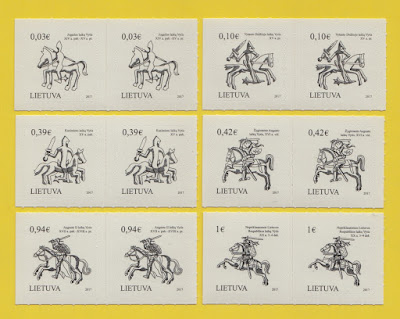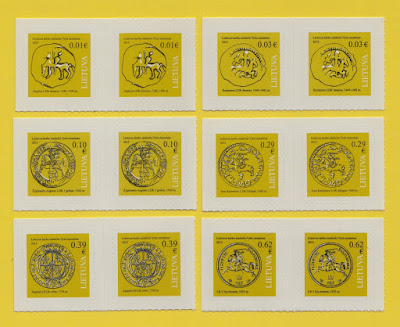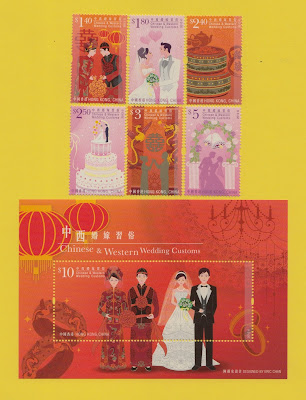SWITZERLAND STAMP SCENE
Examine the borders on Switzerland’s Arms issues
Many details are hidden in the borders of Switzerland’s Pro Juventute stamps from 1918 to 1926 featuring the cantonal arms. The tiny figures offer clues to Switzerland’s history and culture.
RICHARD T. HALL - LINNS STAMP NEWS
The 1918 series: the 10-centime semipostal stamp features the arms of canton Uri, with the border showing an apple with an arrow through it; the 15c, the arms of canton Geneva, with the strings of pearls in the border representing the canton as the center of jewelry trade.
Have you ever looked closely at the Pro Juventute issues of 1918 to 1926 showing Swiss cantonal arms? Of course, you say. They show the coat of arms of each of the then 25 cantons.
But have you noticed the tiny figures to the right and left of the arms? Let’s take a look at these, because they have ties to the canton whose arms are featured.
Let’s start with the first of the series, the 1918 10-centime semipostal stamp showing the arms of canton Uri (Scott B10), one of the first three cantons of 1291. The cantonal capital of Uri is Altdorf, of William Tell fame. So what better to border the arms with than an apple with an arrow through it.
The next stamp in the series, the 1918 15c, shows the arms of canton Geneva (Scott B11), one of the cantons to join the Confederation in 1815 after the Napoleonic Wars. Geneva, the capital of the canton, is known, among other things, as a center of the jewelry trade. Strings of pearls refer to that.
The 1919 issues: shows the arms of canton Vaud (10c), and the two half-cantons of Nidwalden (7½c) and Oberwalden (15c). The borders feature bunches of grapes (Vaud), a bunch of “Morgensternen” or “Morning Stars” (Nidwalden), and halberd blades (Oberwalden)
The 1919 issues show the arms of canton Vaud (Scott B13, a 10c stamp) and the two half-cantons of Nidwalden (B12, a 7½c stamp) and Oberwalden (B14, a 15c semipostal). Canton Vaud was another of the group that joined the Confederation in 1815, while Unterwalden (the name of the full canton) is also one of the three original cantons in the Confederation.
The borders of the two half cantons refer to the struggles they faced in gaining their independence. The border of the Nidwalden stamp shows a bunch of “Morgensternen” or “Morning Stars”.
A Morning Star was a root gnarl into which iron spikes had been driven, attached to a chain, and then whirled over the head of the soldier. These were lethal weapons during close-in fighting. The Oberwalden border is composed of halberd blades, another very effective weapon at close quarters.
The border of the Vaud stamp shows bunches of grapes, referring to the vineyards on the slopes above the Lake of Geneva responsible for most of the wines of Switzerland.
The 1920 issues: the arms of cantons Schwyz (7½c stamp), Zurich (10c stamp), and Ticino (15c stamp). The borders picture a raised hand with the thumb and two fingers extended (Schwyz), gears (Zurich), and bricks (Ticino).
The 1920 issues show the arms of cantons Schwyz (Scott B15, a 7½c stamp), Zurich (B16, a 10c stamp), and Ticino (B17, a 15c stamp). Canton Schwyz is the third of the three original cantons and is the home of the field at Rutli, where the Confederates swore their allegiance to their cause by raising their hand with the thumb and two fingers extended, shown in the border of the stamp. This gesture is still used to signify a Swiss citizen’s allegiance to the Confederation.
Canton Zurich joined the Confederation in 1351 and is the commercial and financial center of Switzerland. What better way to show this than gears.
Canton Ticino is another late entry to the Confederation, having joined in 1803. The border is made up of bricks symbolizing the construction trade of many of the inhabitants.
The 1921 issue: the arms of cantons Valais (10c stamp), Bern (20c stamp), and Switzerland (40c stamp). The borders feature cherries, grapes, and plums (Valais); heads of wheat (Bern); Count Rudolf I of Hapsburg at the left and William Tell with his crossbow at the right (Switzerland).
The 1921 issue shows the arms of cantons Valais (Scott B18, a 10c stamp) and Bern (B19, a 20c stamp).
The 40c stamp of the 1921 issue features the Swiss arms (B20). The border figures of this stamp are Count Rudolf I of Hapsburg at the left and William Tell with his crossbow at the right, the two proponents in the William Tell legend.
Canton Valais is another of the group that joined the Confederation in 1815. The border of the stamp shows cherries, grapes, and plums, referring to the orchards and vineyards of the canton.
Canton Bern joined the Confederation in 1353 and is known as the bread basket of Switzerland, hence the heads of wheat in the border of the stamp.
The 1922 issue: the arms of cantons Zug (5c stamp), Fribourg (10c stamp), Luzern (20c stamp), and Switzerland (40c stamp). The borders show fish (Zug), bishop’s miters and rosaries (Fribourg), sailboats encircled by rosaries (Luzern), and Duke Leopold III of Austria at the left and Arnold von Winkelried with an armful of spears and a battle ax at the right (Switzerland).
The 1922 issue shows the arms of cantons Zug (Scott B21, a 5c stamp), Fribourg (B22, a 10c denomination), and Luzern (B23, a 20c stamp). The fourth stamp (B24), a 40c denomination, shows the Swiss arms bordered by Duke Leopold III of Austria at the left and Arnold von Winkelried with an armful of spears and a battle ax at the right.
These men represent the Battle of Sempach in 1386, an important battle for Swiss independence. Winkelried is famed for sacrificing himself by grasping as many of the Austrian spears as he could to open a gap in the battle line to allow the Confederates passage to kill the Duke.
Canton Zug joined the Confederation in 1352 and is the location of the Lake of Zug. The lake is the only place where the Zuger Rotel, a fish reknowned for its flavor, is found, hence the fish in the border of the stamp.
Canton Fribourg joined the Confederation in 1481. Its capital, the city of Fribourg, is the seat of the Bishopric of Fribourg, Lausanne, and Geneva, hence the bishop’s miters and rosaries in the border.
Confederation in 1332. On the Lake of Lucerne (officially the Lake of the Four Cantons, Vierwaldstattersee), the border of the stamp shows sailboats encircled by rosaries referring to the pleasures of life on the lake and the strong Catholic influence in the canton.
The 1923 issue: the arms of Half-Canton Basel Stadt (5c stamp), Canton Glarus (10c stamp), Canton Neuchatel (20c stamp), and Switzerland (40c stamp). The borders show crozier heads (Basel), repeating Edelweiss pattern (Glarus), watches (Neuchatel), and French Dauphin Louis XI and a Swiss soldier with many arrows piercing his body from the Battle of St. Jakob an der Birs fought in 1444 (Switzerland).
The 1923 issue shows the arms of cantons Glarus (Scott B26, a 10c stamp) and Neuchatel (B27, a 20c denomination) and of the half-canton of Basel Stadt (B25, a 5c stamp).
The Swiss arms on the high denomination 40c stamp (B28) show the French Dauphin Louis XI and a Swiss soldier with many arrows piercing his body from the Battle of St. Jakob an der Birs fought in 1444.
The battle was a terrible defeat for the Swiss because they were slain to the last man; however, the massive casualties they imposed on the French saved Zurich.
Canton Glarus joined the Confederation in 1352. The border of the stamp shows a repeating Edelweiss pattern, referring to the mountainous character of the canton and its reputation for printed fabrics.
Canton Neuchatel joined the Confederation in 1815, the final member of the group that became part of the Confederation at the end of the Napoleonic Wars. The canton is the home of the watch-making industry, hence the watches (interestingly, none showing the same time) in the border of the stamp.
The Canton of Basel joined the Confederation in 1501. Conflict between those living in the countryside and those living in the city of Basel led to a revolt in 1833, which resulted in the canton being split into two half-cantons. The half-canton of Basel Stadt encompasses the city of Basel and is the seat of the Bishopric of Basel, hence the crozier heads in the border.
The 1924 issue: the arms of cantons Appenzell (5c stamp), Solothurn (10c stamp), Schaffhausen (20c stamp), and Switzerland (30c stamp). The borders feature Swiss cow bells (Appenzell); banners and mitres (Solothurn); grapes (Schaffhausen); and two soldiers from the Burgundian Wars of 1474-77 between the forces of Charles, Duke of Burgundy, and the Swiss (Switzerland).
The 1924 issue shows the arms of cantons Solothurn (Scott B30, a 10c stamp) and Schaffhausen (B31, a 20c stamp) and of the half-canton of Appenzell Inner-Rhoden (B29, a 5c stamp) along with the arms of Switzerland (B32, a 30c stamp). The 30c stamp has the figures of two soldiers from the Burgundian Wars of 1474-1477 between the forces of Charles, Duke of Burgundy, and the Swiss.
Canton Solothurn joined the Confederation in 1491. The border of the stamp shows banners, referring to the Cathedral of St. Urs, and mitres, referring to the fact that the Bishop of Basel had his residence in Solothurn.
Canton Schaffhausen joined the Confederation in 1501. The Hallau region of the canton is famous for its wines, hence the grapes in the border.
The Canton of Appenzell joined the Confederation in 1513, but the Protestant Reformation resulted in battles between the Catholics and Protestants in the canton. In 1531, it was decided to split the canton along faith lines. Each town in the canton decided if they wanted to join the Catholic Inner-Rhoden or the Protestant Ausser-Rhoden, resulting in a patchwork of borders between the two half-cantons. The border of the Appenzell Inner-Rhoden stamp shows the famous Swiss cow bells, referring to the herds of cattle grazing on the lush pastures of the region.
The 1925 issue: the arms of cantons St. Gallen (5c stamp), the half-canton of Appenzell Ausser-Rhoden (10c), Graubunden (20c stamp), and Switzerland (30c stamp). The borders picture embroidery (St. Gallen), hand embroidery (Appenzell Ausser-Rhoden), grape leaves (Graubunden), and soldiers from the Battle of Marignano of 1515 (Switzerland).
The 1925 issue shows the arms of cantons St. Gallen (Scott B33, a 5c stamp) and Graubunden (B35, a 20c stamp) and the half-canton of Appenzell Ausser-Rhoden (B34, a 10c stamp) together with the Swiss arms (B36, a 30c stamp). The border of the latter stamp shows soldiers from the Battle of Marignano of 1515. It was this battle that led to the Swiss becoming a neutral power in the European wars of the era, when the Swiss realized that they were fighting fellow Swiss serving as mercenaries for their enemy. Canton St. Gallen joined the Confederation in 1803. The canton is famous for its embroidery, both handmade and machine made, hence the embroidery in the border of the stamp. Canton Graubunden also joined the Confederation in 1803. The border of the stamp shows grape leaves. Like Half-Canton Appenzell Inner-Rhoden, Appenzell Ausser-Rhoden was created in 1531 out of Canton Appenzell. The border of the stamp shows hand embroidery.
The 1926 issue: the arms of Canton Thurgau (5c stamp), Half-Canton Basel Landschaft (10c stamp), Canton Aargau (20c stamp), and Switzerland (30c). The borders depict branches of pear trees (Thurgau), ribbons (Basel Landschaft), carrots (Aargau), and the sculpture The Lion of Lucerne, with a sword blade protruding from his side (Switzerland).
The final stamps of the Cantonal Arms series were issued in 1926, showing the arms of cantons Thurgau (Scott B37, a 5c stamp) and Aargau (B39, a 20c stamp) and that of Half-Canton Basel Landschaft (B38, a 10c stamp), together with the Swiss arms on the high denomination (B40, a 30c stamp). The 30c stamp shows the sculpture THE LION OF LUCERNE, a sword blade protruding from his side, commemorating the Swiss Guards who were slain in the Tuileries Palace in 1792 during the French Revolution.
Canton Thurgau joined the Confederation in 1803. The border of the stamp shows branches of pear trees, referring to the large number of orchards in the area.
Canton Aargau also joined the Confederation in 1803. The border of this stamp shows carrots, referring to the agricultural products of the region.
The final stamp in the series is that of the half-canton of Basel Landschaft. As explained with the Basel Stadt stamp, the half-canton was formed in 1833 when the canton of Basel was split between the city and countryside (Landschaft). The border of the stamp shows ribbons, ribbon making being an important industry of the region.
See what you can learn by closely examining your stamps!

















































